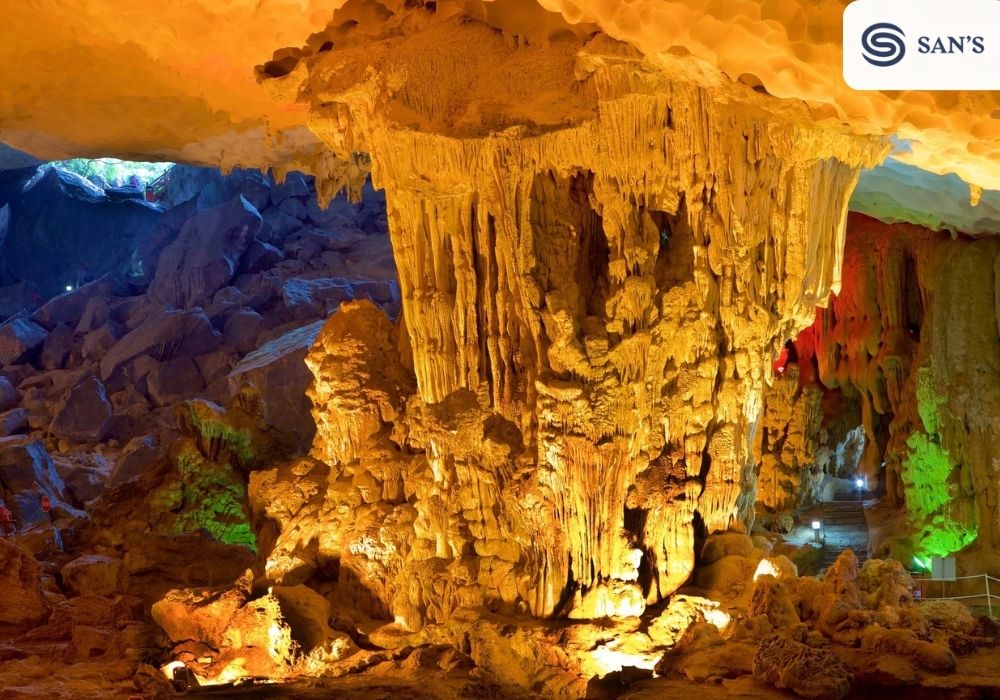In 2023, the journey to Bai Tho Mountain encapsulates more than a simple travel itinerary; it symbolizes an adventure into the extraordinary landscapes of Vietnam. Nestled in the heart of the UNESCO World Heritage Site of Ha Long Bay, Bai Tho Mountain, often referred to as Poem Mountain, stands as a testament to the region’s breathtaking beauty and cultural richness. The quest on how to get to Bai Tho Mountain is a journey that offers travelers a unique blend of panoramic vistas, serene nature, and a deep dive into the cultural tapestry of Vietnam. As the world gradually reopens, this year presents a perfect opportunity for adventurers and nature enthusiasts to rediscover the enchanting beauty of Ha Long Bay through the ascent of Bai Tho Mountain, a trip that promises not just a destination, but an experience etched in the memory of every traveler.
Why Visit Bai Tho Mountain?

Embarking on the journey of how to get to Bai Tho Mountain unveils a natural masterpiece at the heart of Ha Long Bay. The mountain’s summit provides a breathtaking panoramic view of the bay, where the interplay of limestone cliffs and emerald waters creates a mesmerizing scene. This vista is not just a feast for the eyes but a haven for photographers, especially during the magical hours of sunrise and sunset, when the sky paints the bay in spectacular colors.
Beyond its visual grandeur, Bai Tho Mountain is a mosaic of history and culture. Its very name, meaning ”Poem Mountain”, echoes a rich heritage, tying it to legends and poetry that celebrate the beauty of Vietnam. The mountain, therefore, offers more than a scenic view; it provides a pathway to understanding the cultural heart of the region. A visit to Bai Tho Mountain is an essential chapter in the story of how to get to Bai Tho Mountain combining the allure of natural wonder with the depth of historical significance.
Preparing for Your Trip

Before embarking on the journey of how to get to Bai Tho Mountain, it’s crucial to prepare adequately to ensure a fulfilling and safe experience.
Best Time of Year to Visit
- The optimal period to plan your visit is between October and April. This timeframe aligns with Ha Long Bay’s cooler and drier season, offering ideal hiking conditions and clearer views from the mountain. The wetter months, from May to September, are less advisable due to the slippery trails and reduced visibility.
Essential Items to Pack
- Robust Hiking Shoes: The varied terrain demands sturdy footwear.
- Hydration and Snacks: Essential for maintaining energy, especially in warmer weather.
- Sun Protection: Equip yourself with sunscreen, sunglasses, and a hat to combat the sun’s rays.
- Camera: A must-have to capture the stunning scenery.
- Appropriate Clothing: Opt for lightweight, breathable attire and layer up in cooler months.
- Rain Gear: A compact raincoat or poncho can be invaluable for unexpected rainfall.
Considerations for Weather and Terrain
- Weather Updates: Stay informed about the day’s forecast to avoid harsh conditions.
- Early Start: Beginning your hike early can lead to a more peaceful and cooler trek.
- Local Advice: Consult with local guides or information centers for the latest trail information and safety tips.
With these preparations in mind, your quest on how to get to Bai Tho Mountain will not only be a journey to a stunning destination but also an enjoyable and safe adventure.
>>> Read more: Unveiling the Best Times to Visit Bai Tho Mountain
How to Get to Bai Tho Mountain in 2023

Navigating your way to Bai Tho Mountain is an integral part of the adventure. Here’s a detailed guide on how to reach this scenic destination from major nearby cities.
From Hanoi
- By Bus: Catch a bus from Hanoi’s Giap Bat or My Dinh bus stations to Ha Long City, which takes about 4-5 hours. From there, you can take a local taxi to Bai Tho Mountain.
- By Train: While there’s no direct train to Ha Long Bay, you can travel to Hai Phong and then take a bus or taxi to Ha Long City.
- By Car: Renting a car allows for a more flexible journey. The drive takes approximately 3-4 hours via the new Hanoi-Hai Phong-Quang Ninh highway.
- By Bike: For the more adventurous, a bike trip can be exhilarating but requires careful planning and physical readiness.
From Hai Phong
- By Bus: Regular buses run from Hai Phong to Ha Long City, taking about 1.5-2 hours.
- By Car or Bike: The journey by car or bike is relatively straightforward, following the Hai Phong – Ha Long highway.
- Tips for Navigating
Local Transportation
- Plan Ahead: Check bus or train schedules in advance and allow for flexibility in travel plans.
- Local Taxis: Once in Ha Long City, taxis are a convenient way to reach Bai Tho Mountain. Ensure the taxi is metered or agree on a fare beforehand.
- Local Guidance: Don’t hesitate to ask locals or your accommodation for advice and directions.
- Navigation Apps: Utilize GPS and navigation apps for real-time directions and traffic updates.
Understanding the various transportation options and tips will make your how to get to Bai Tho Mountain journey smooth and enjoyable.
Climbing Bai Tho Mountain
The trek to the summit of Bai Tho Mountain is as rewarding as it is challenging. Here’s a detailed guide on what to expect and how to safely navigate the hike.
Trekking Route
- The journey begins at the foot of Bai Tho Mountain, located in the heart of Ha Long City.
- The trailhead is somewhat hidden, often behind a local’s house, so asking for directions is advised.
- The hike involves climbing steps and navigating through some rocky and narrow paths.
- Along the way, you’ll pass through lush greenery and may encounter local wildlife.
- The trail leads to an opening with a magnificent view of Ha Long Bay, ideal for a rest and photo session.
Safety Tips
- Stay on the Path: To ensure your safety, stick to the marked trail.
- Hydration: Carry enough water, as there are no water sources along the way.
- Wear Appropriate Gear: Proper hiking shoes and comfortable clothing are a must.
- Weather Watch: Be mindful of the weather conditions. Avoid the hike during rainy or stormy weather.
- Travel in Groups: If possible, hike with a companion or group for added safety.
Duration and Difficulty
- The hike to the summit of Bai Tho Mountain typically takes about 1 to 1.5 hours, depending on your pace and fitness level.
- The climb is moderately challenging, with some steep and narrow sections that require caution.
- The descent is generally quicker but requires careful footing.
Understanding the intricacies of the route, preparing for the hike’s demands, and respecting the mountain’s natural environment are crucial elements of your journey on how to get to Bai Tho Mountain. This trek not only leads you to stunning views but also offers a chance to connect deeply with the natural world.
What to See and Do at the Top
Reaching the summit of Bai Tho Mountain is a moment of triumph, where you’re greeted with sights and experiences that make the climb worthwhile.
View and Landscape
- As you reach the top, you’re welcomed by a 360-degree panoramic view of Ha Long Bay’s stunning landscape. The horizon is dotted with countless limestone karsts jutting out of the emerald green waters, creating a picturesque mosaic that changes with the light.
- The bustling city of Ha Long, with its colorful buildings, contrasts beautifully against the serene backdrop of the bay. On clear days, the sky’s reflection on the water adds a surreal quality to the already magnificent scenery.
Lookout Points and Photo Spots

- Near the summit, there’s a well-known lookout point marked by a large Vietnamese flag, which is a popular spot for capturing the essence of Ha Long Bay.
- Another notable spot is the rocky outcrop that offers an unobstructed view of the bay, ideal for panoramic shots and sunrise or sunset photos.
- The top also features various boulders and natural formations that provide unique frames for creative photography.
Cultural and Historical Landmarks
- While the focus is often on the natural beauty, the top of Bai Tho Mountain is also a place rich in cultural and historical significance.
- Keep an eye out for the remnants of old fortifications and lookout posts, which tell stories of the mountain’s strategic importance in the past.
- The area is dotted with small shrines and altars, reflecting the spiritual connection locals have with the mountain. These sites are a reminder to respect the cultural significance of the place as much as its natural beauty.
The summit of Bai Tho Mountain is not just a destination but a journey through the visual, cultural, and historical tapestry of Ha Long Bay. It’s a place where each viewpoint opens a new perspective, not only on the landscape but also on the rich tapestry that is Vietnam.
Tips for Responsible Tourism
Embarking on the journey of how to get to Bai Tho Mountain is not only about reaching a destination but also about how we interact with and impact the environment and local communities along the way. Here are some essential tips for responsible tourism:
Preserving the Natural Environment
- Carry Out Trash: As you figure out how to get to Bai Tho Mountain, plan to leave no trace behind. Ensure all waste is carried out and disposed of properly.
- Respect Wildlife: During your hike, you may encounter various wildlife. It’s crucial to observe them from a distance without causing disturbance.
- Stick to Paths: To protect the mountain’s fragile ecosystem, stay on designated trails and paths.
Cultural Sensitivity and Interacting with Locals
- Understand Local Traditions: Research and respect the cultural practices of Ha Long Bay’s local communities. This understanding is as important as knowing how to get to Bai Tho Mountain.
- Consent for Photography: Always seek permission before photographing local people or their homes.
- Support the Local Economy: Engage with local businesses and artisans, enhancing your experience and benefiting the community.
Leaving a Positive Impact
- Educate Yourself: Prior to your hike, learn about the environmental concerns and cultural heritage of the area.
- Volunteer Opportunities: If there are conservation projects or community initiatives, consider contributing your time or resources.
- Advocate Responsible Travel: Share your experiences and promote responsible tourism practices to others planning on how to get to Bai Tho Mountain.
By traveling responsibly, you contribute to the sustainability of Bai Tho Mountain’s natural beauty and cultural heritage, making your journey there meaningful and impactful.
Alternatives to Bai Tho Mountain
While Bai Tho Mountain offers a unique perspective of Ha Long Bay, the region is abundant with other attractions that promise equally enriching experiences. Here are some alternatives and complementary activities to consider:
Other Nearby Attractions in Ha Long Bay
- Sung Sot Cave: Explore the largest and most impressive cave in Ha Long Bay, known for its stunning stalactites and stalagmites.

- Cat Ba Island: Just a short boat ride away, this island offers a mix of forested hills, rugged coastlines, and sandy beaches.
- Floating Villages: Visit the floating villages like Cua Van or Vung Vieng to see the unique way of life of the local fishermen.
Lesser-Known Hiking Trails and Viewpoints
- Titov Island: Offering a less strenuous climb compared to Bai Tho Mountain, Titov Island has a viewpoint that provides a panoramic view of Ha Long Bay.
- Ban Sen Island: A less visited spot, this island offers a quiet and natural setting for hiking and exploring untouched landscapes.
- Yen Tu Mountain: This sacred mountain is famous for its beautiful pagodas and temples, providing a spiritual dimension to your hike.
Combining Bai Tho Mountain with Other Local Experiences
- Kayaking in Ha Long Bay: After climbing Bai Tho Mountain, enjoy a kayaking trip through the bay’s calm waters to explore hidden caves and islets.
- Culinary Experiences: Complement your adventure with local gastronomic delights, including fresh seafood and traditional Vietnamese dishes.
- Cultural Tours: Participate in guided cultural tours to learn more about the history and traditions of the Ha Long Bay region.
These alternatives not only offer varied experiences but also showcase the diverse beauty and cultural richness of Ha Long Bay, making your visit a multifaceted adventure.
In the article, San Travel has meticulously outlined how to get to Bai Tho Mountain, offering readers a comprehensive guide to navigate their way to this stunning landmark in Ha Long Bay. From providing detailed routes from major nearby cities like Hanoi and Hai Phong to exploring various transportation modes such as buses, trains, cars, and bikes, the guide ensures that travelers are well-equipped with all the necessary information for their journey. Furthermore, San Travel emphasizes the significance of responsible tourism, highlighting the importance of preserving the natural environment, respecting the local culture, and positively impacting the region. This guide not only aids in planning the journey to Bai Tho Mountain but also fosters a deeper understanding and appreciation of the area’s natural beauty and cultural heritage.



Comment (0)